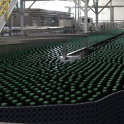|
I usually give it two weeks before I open bottles. Last night I opened up my last bottle of amber ale, and it was 5x better than the ones I drank before that (~6 weeks in between the very last bottle and the one before that). I think between 2-3 weeks you won't be able to notice too much but does open up more after that.
|
|
|
|

|
| # ? May 17, 2024 02:57 |
|
One week is good for a learning thing. Except for some special case its going to be slightly "green" so its usually not at a stage for large scale sharing but still definitely drinkable.
|
|
|
|
Josh Wow posted:If you are using the same line and it wasn't foaming before there's a few things it could be: It's different line, I just meant the pre-kegerator corny keg QD to faucet line I had to manually hook up to the keg every time I used it. The tower seems chlly and I added some foam insulation up there as well. It's been running for months now and quite chilly, but I'll check for leaks and add some line. Thanks!
|
|
|
|
zedprime posted:One week is good for a learning thing. Except for some special case its going to be slightly "green" so its usually not at a stage for large scale sharing but still definitely drinkable. Opening one bottle after a week is as important as tasting the gravity samples during fermentation. It helps you understand what is going on throughout the entire process.
|
|
|
|
Napoleon Bonaparty posted:Been too busy to get around to posting it, but I finally bottled last week. eight 750mls, and sixteen 500mls, full to the necks. That's about 3.7 gallons from my slightly less than 5 gallon batch. My recipe recommended I use a 1 cup priming sugar, 2 cup of water syrup recipe for carbonating, but I left some in the pot because I really don't like the idea of my brand new bottles blowing up. A 5 gallon batch usually does get reduced, right? I lost some from the boil, lost some from evaporation, and lost some from it bubbling out of the airlock and all over the tub I put the bucket in. The amount of priming sugar you put in should depend on the final volume after fermentation. There are calculators online so you can get the correct amount. quote:Anyways, it's been a week, which is standard "ready, but not aged all the way" time, from what I've learned. Should I try a small bottle? Does a week really change it that much? It's my first batch so I'd just like to know if it's going to be remotely drinkable. I don't have a "wine thief" or whatever that is. I did consider just using a turkey baster and grabbing some during the bottling phase, but by that time we'd thrown out all of the sanitized water.
|
|
|
|
I'm not sure I'm a fan of White Labs Lacto 677 - I attempted to use it instead of throwing in some acid malt to get the lacto going in my berliner, and it wasn't getting nearly as tart as the previous batch I made when I just used acid malt. I decided to throw some acid malt in my fermentor and it's twice as sour in less than 24 hours.
|
|
|
|
Bag of Sun Chips posted:I'm not sure I'm a fan of White Labs Lacto 677 - I attempted to use it instead of throwing in some acid malt to get the lacto going in my berliner, and it wasn't getting nearly as tart as the previous batch I made when I just used acid malt. Lacto D. Is supposed to be a more subdued acidity if i recall. You want lacto brevis for more tart
|
|
|
|
BLARGHLE posted:Those are both too big for my setup, and also I already bought the ingredients for Jo3sh's recipe. Maybe I can do them whenever I get around to upgrading! I don't want to seem pushy about using my recipe (although it is an excellent RIS), I'm just trying to illustrate that with a little creativity a smaller mash tun isn't as limiting as it might initially seem. *If my math is wrong, I'm sure I'll have 6 people correcting me, although I'm pretty sure it's correct.
|
|
|
|
Discomancer posted:If you have a bucket, they usually have markings in the side so you can see what your actual bottling volume is and calculate the appropriate amount of sugar. The bucket is a dirty stinking liar.
|
|
|
|
Just started my very first brew and I have a question. The guide I've been following says it is advisable to transfer the beer after most of the fermentation is done, because it will reduce the amount of dead yeast in your brew and while the first part of the fermentation requires lots of room because of foam, for the second part having as little as possible oxygen is better. When transferring I should keep out the yeast, but do I include the foamy stuff or keep it out as well?
|
|
|
|
For a lot of beers you don't even need to transfer until you're ready to bottle, unless you're making something that requires extensive aging like barely-wine or Imperial stouts. The yeast even clean up after their messes when they are done, so some say its more beneficial not to transfer.
|
|
|
|
BioTech posted:Just started my very first brew and I have a question. When you're transferring, you should be using a siphon of some sort which will be drawing the liquid below the surface of the krausen (the foamy part) but above the yeast cake at the bottom of the fermenter.
|
|
|
|
rockcity posted:When you're transferring, you should be using a siphon of some sort which will be drawing the liquid below the surface of the krausen (the foamy part) but above the yeast cake at the bottom of the fermenter. Yeah, I have one of those, but unless I am really misunderstanding how it works won't some foam get in if the liquid level drops enough? It would probably sputter because of the air and lose pressure quickly, but there should be some krausen able to make the transfer with the last of the liquid.
|
|
|
|
Don't bother transferring. Dead yeast aren't really a problem unless it is going to be sitting for months, and after fermentation all of the oxygen in the top of the fermenter has been pushed out. Transferring it like that can only introduce more oxygen. If you do transfer it, don't worry about a little bit of yeast or crud getting in there; it doesn't matter.
|
|
|
|
BioTech posted:Just started my very first brew and I have a question. Don't bother transferring. The guide you're following is rehashing old, outdated fears about autolysis, which simply doesn't happen at homebrew pressures in the kind of timeframe a typical fermentation/conditioning takes. Just leave it on the yeast cake. I've left non-sour beers on the yeast cake for as long as 3 months and been totally fine.
|
|
|
|
Thanks for the answers. I guess the good news is I can start brewing a second batch right away. I already bought a glass jar for the second part of the fermentation and your information means it won't have any other use for it now since I have a separate container for the bottling already. Is there a rough guideline to how much extra space there should be in the container? I'm brewing 10L in a 30L container now, which is more than enough room. Can I do the same 10L in the 15L jar or is there some ratio how much room you need for the krausen and air getting pushed out?
|
|
|
|
Bag of Sun Chips posted:I'm not sure I'm a fan of White Labs Lacto 677 - I attempted to use it instead of throwing in some acid malt to get the lacto going in my berliner, and it wasn't getting nearly as tart as the previous batch I made when I just used acid malt. Commercial lactos aren't very good at souring. Rumor has it that both Wyeast and White Labs are going to release lacto brevis, which is more acid-forward and also more hop tolerant. It's the same lacto that Cascade uses. Another option is to do a lacto starter with grain.
|
|
|
|
BioTech posted:Can I do the same 10L in the 15L jar or is there some ratio how much room you need for the krausen and air getting pushed out? You should be fine, but use a blowoff tube instead of an airlock whenever you aren't sure.
|
|
|
|
ChickenArise posted:You should be fine, but use a blowoff tube instead of an airlock whenever you aren't sure. This, pretty much. There are some yeast strains for which no amount of headspace is enough (see WY3787) so a blowoff tube is always safest.
|
|
|
|
nmfree posted:According to the chart, one can mash 12# in a 5 gallon tun. The Old Rasputin clone I linked has 12.25# of mashing grains, so if you substituted another pound of DME for 1.7# of 2-row you can shrink the mash to a little over 10.5# but still hit the final gravity.* That thought had crossed my mind as well, but not until after I bought ingredients. Maybe next time! Really, I'd rather just build a RIMS or HERMS setup and start kegging again and  all over the place, but I have so many other projects I'm trying to get going at the same time, so I guess I'll just have to keep using my little mash tun for now. all over the place, but I have so many other projects I'm trying to get going at the same time, so I guess I'll just have to keep using my little mash tun for now.
|
|
|
|
ExtremistCow posted:Commercial lactos aren't very good at souring. Rumor has it that both Wyeast and White Labs are going to release lacto brevis, which is more acid-forward and also more hop tolerant. It's the same lacto that Cascade uses. The culture should be out RIGHT NOW. https://www.wyeastlab.com/vssprogram.cfm?website=3
|
|
|
|
I'm finally able to get back to brewing this weekend after a long hiatus
|
|
|
|
I came to the conclusion that brewing on my "big rig" setup is not something I want to do every weekend. It's great for filling up kegs (15 gallon setup) but I really needed something to test recipes with. I think I'm about to start enjoying home brewing again. With that thought, I decided I wanted to expend as little effort as possible on brew day but still do AG. BIAB seemed to make sense. I also didn't want to fool with propane so I did some research on induction and committed to making it work. Here's my 1-2.5G BIAB Induction system. http://imgur.com/a/DUEo5 Really enjoying the whole concept. Brewing a cream ale in it tomorrow!
|
|
|
|
Attempted to brew 55 gallons of a barley wine today - dude in club is horrible at numbers and checking poo poo, hit 1.070 on the first boil and 1.090 on the second. I was off bottling our 20 gallons of wine/beer wild beer experiment to care. Shared brew days, yay!
|
|
|
|
I am afraid that off flavor I have been worrying about came back for this recent batch. My theory now is that I'm skunking the beer just a little bit from leaving it out on the counter, despite covering it in a drop cloth. I think the wit was out for three weeks with the cloth around it, but since that fabric is thin, some stuff still got through in that time. I'm going to do some experiments with the batch to see. Like, I will set some right out in the sun and see if the magnitude of that flavor gets worse, or if I wind up with something else entirely.
|
|
|
|
My dunkel is finally done lagering and I'm bottling it today. Which means the keezer is open and it's back to ales tomorrow with a Timothy Taylor Landlord clone. Happy brew weekend everyone!
|
|
|
|
Brewing with cherries - should they depitted or not? While I'm talking about it - when you guys freeze fruits, do you squash them at all in the bag or primarily leave the fruits untouched?
|
|
|
|
Bag of Sun Chips posted:Brewing with cherries - should they depitted or not? I depitted cherries when I used them, but I'm not sure if there's an official recommendation. When you freeze fruits, the cells bursting does a pretty good job making them mushy regardless of what you do. It might not hurt to mush them up some more after freezing, but it probably doesn't make a huge difference either way.
|
|
|
|
Long term exposure to pits, supposedly, can be negative. It's one of those sorta untested/anecdotal homebrew things though.
|
|
|
Bag of Sun Chips posted:Brewing with cherries - should they depitted or not? I'm aging my brett rye saison on sour cherries from the garden and having them unpitted, like Belgians do with Krieks. The stones add almost an almond taste after many months. If it's going to spend a short time depit or doing a clean beer I recommend depitting if not, unpitted.  Daedalus Esquire posted:Long term exposure to pits, supposedly, can be negative. It's one of those sorta untested/anecdotal homebrew things though. Fluo fucked around with this message at 22:11 on Jul 12, 2014 |
|
|
|
|
Bag of Sun Chips posted:Brewing with cherries - should they depitted or not? From anecdotes, it goes back and forth. Some Belgian brewers insist that the stones add a nonnegotiable bittering flavor. Others say its fine to do without. I used a cherry puree for a Dawson's Kriek recipe and it turned out great. I've done fruits both ways. I usually puree the fruit in a blender and then freeze the goop. I don't have any science to back me up, but I think I get better sugar/flavor extraction.
|
|
|
|
Fluo posted:I'm aging my brett rye saison on sour cherries from the garden and having them unpitted, like Belgians do with Krieks. The stones add almost an almond taste after many months. If it's going to spend a short time depit or doing a clean beer I recommend depitting if not, unpitted. I brewed a Flanders pale ale (It's the most appropriate name I've come up with for my sour I'm still homebrewing, but not as often as before, and I'm primarily repeating old favorites instead of brewing a new batch every time. I finally reformulated and rebrewed my 3% table beer, and it came out the best it ever has.  /edit: Josh Wow posted:That's funny, I always thought that malt was super smokey and harsh. I'll use it for at most 10-15% of my grain bill where I'll go up to 100% with Weyermann smoked malt. Of course compared to peat smoked malt it's nothing, I use literally 2-3 oz of that for a 5 gallon batch. The Weyermann stuff is definitely the gentlest and most palatable of the bunch. They also make an oak-smoked wheat for Grätzer/Grodziskie that's a bit bolder but also delicious. I love the Briess smoked malt myself, and use it at about a 15-20% rate for a smoked brown ale I've brewed a few times. It ends up as a definite smoky characteristic without being overly harsh. I know another guy who once used 100% Briess smoked malt for a rauchbier, and it was one of the most amazing smoked beers I've ever had - very smoky but still drinkable and incredibly smooth. He has amazing expertise in brewing lagers in general, though. As for peated malt, generally don't go above 1% unless you want your beer to taste like burning tires.  Josh Wow posted:I got an electric smoker this year and have been smoking my own grains and it has turned out great so far. The most I've done is 60% of the grist but I've got two rauchbiers fermenting now that are 100% home smoked malt that'll be ready in about 3 weeks. That's awesome! What kind of wood are you using to smoke your malt? Have you tried to smoke anything besides barley? I imagine that'd be fun as hell to make smoked wheat for a Grätzer, but I'm also intrigued by the idea of smoked rye. RocketMermaid fucked around with this message at 05:54 on Jul 13, 2014 |
|
|
|
Ubik posted:I'm still homebrewing, but not as often as before, and I'm primarily repeating old favorites instead of brewing a new batch every time. I finally reformulated and rebrewed my 3% table beer, and it came out the best it ever has. So... dish with the recipe 
|
|
|
|
Ubik posted:That's awesome! What kind of wood are you using to smoke your malt? Have you tried to smoke anything besides barley? I imagine that'd be fun as hell to make smoked wheat for a Grätzer, but I'm also intrigued by the idea of smoked rye. For the two rauchbiers with 100% smoked malt that I'm lagering right now I did slightly different blends of equal amounts of wood. One is a smoked vienna lager that's: 70% vienna 30% munich I Smoked with 1 oz each of apple, pecan and hickory. The other is a smoked munich dunkel that's: 65% munich I 30% vienna 5% caramunich I Smoked with 1 oz each of apple, cherrywood and hickory. I really wanted to do a mesquite smoked pilsner or helles this summer since I loved Shiner's Smokehaus but never got around to it. Maybe next year.
|
|
|
|
Brewtoad doesn't even have 1469 Yorkshire in their yeast database
|
|
|
|
Syrinxx posted:Brewtoad doesn't even have 1469 Yorkshire in their yeast database Anyway, 1469 is in the database as a custom ingredient. Which one of the 12 custom entries should you use? ¯\_(ツ)_/¯
|
|
|
|
So I just bottled my first batch and based on my starting and ending gravity I'm looking at a 5.8% AC. Will the addition of the priming sugar boost that and if so, how would I calculate it? I'm guessing that I can't use the same old equation since I've now added more stuff to the brew. Also, I'm gonna start a new batch on Wednesday and I had a question about packaged dry yeast. The instructions on the package say to pitch the yeast in a prepared water solution but my tutorial video for my first batch showed the dude just pouring the dry yeast right into the carboy. Will I get better results with one method over the other, or does it not matter?
|
|
|
|
DecentHairJelly posted:So I just bottled my first batch and based on my starting and ending gravity I'm looking at a 5.8% AC. Will the addition of the priming sugar boost that and if so, how would I calculate it? I'm guessing that I can't use the same old equation since I've now added more stuff to the brew. Priming sugar might add like 0.1-0.2% or something. Not a huge difference. For dry yeast, I just pitch it straight in. Letting them rehydrate a bit might help a bit, I suppose, but
|
|
|
|
Yeah, you'll kill a bunch of yeast if you pitch directly into the wort. If it's like 5 gallons of a 1.040 wort it probably won't affect the flavor too much but you should definitely rehydrate if you're pitching into a batch that needs the full cell count of the package. It's super easy and takes like 2 minutes.
|
|
|
|

|
| # ? May 17, 2024 02:57 |
|
internet celebrity posted:Yeah, you'll kill a bunch of yeast if you pitch directly into the wort. If it's like 5 gallons of a 1.040 wort it probably won't affect the flavor too much but you should definitely rehydrate if you're pitching into a batch that needs the full cell count of the package. It's super easy and takes like 2 minutes. I do 2.5-3 gallon batches so I figure it's a bit easier to get away with
|
|
|



































